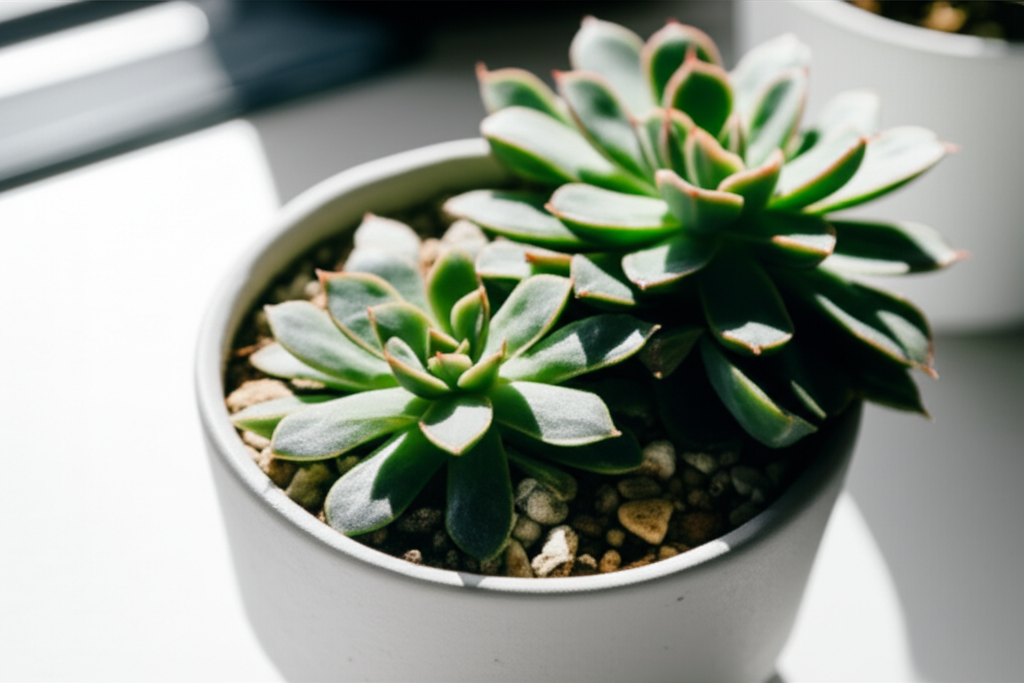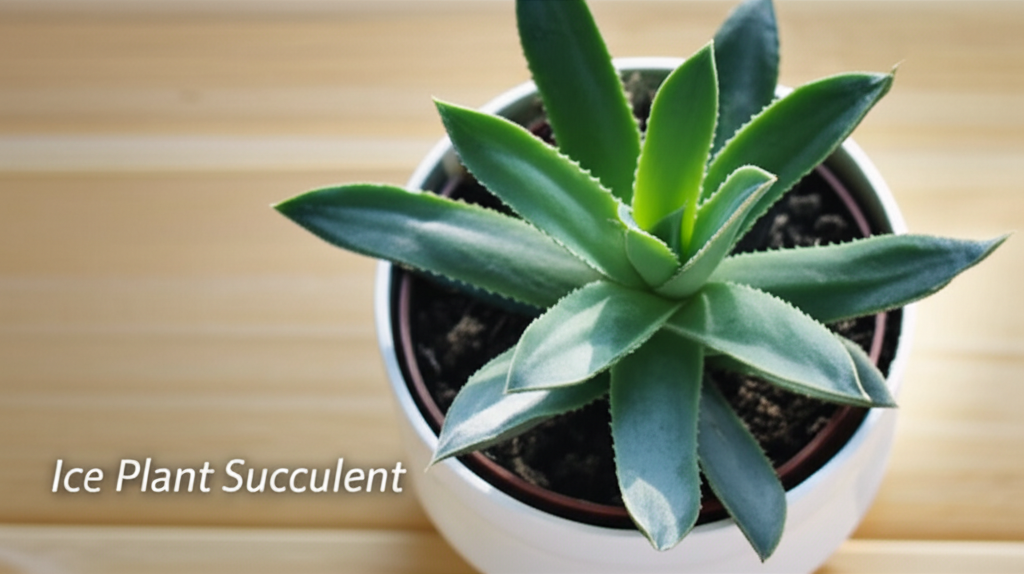The Allure of Ice Plants: Bringing a Touch of Frosty Charm Indoors
Ice plants, scientifically known as members of the Aizoaceae family, are a diverse group of succulents celebrated for their unique aesthetic and remarkable resilience. While the term “ice plant” can refer to a broad spectrum of species, they are most commonly associated with those displaying glistening, transparent structures on their leaves, resembling tiny droplets of ice. These specialized cells, called bladder cells or hydathodes, are thought to help the plant reflect sunlight, reduce water loss, and absorb moisture from the air in arid native environments.
For indoor gardening enthusiasts, ice plants offer an inviting entry point. Their generally low-maintenance nature, coupled with their captivating appearance, makes them ideal for beginners and experienced plant parents alike. Setting up an indoor garden with ice plants is not only achievable but also incredibly rewarding, bringing a touch of unique natural beauty into your living space without demanding excessive time or expertise. This guide will walk you through everything you need to know to cultivate a thriving ice plant succulent garden indoors.
Understanding the Basics: What Makes Ice Plants Ideal for Indoor Gardens?

Before diving into the setup, it’s crucial to understand why ice plants are such excellent candidates for indoor cultivation.
Key Characteristics of Ice Plants
- Drought Tolerance: Like most succulents, ice plants are adapted to survive long periods without water, making them forgiving if you occasionally forget to water them.
- Sunlight Requirements: They thrive in bright light, which is readily available near sunny windows indoors.
- Compact Growth: Many varieties maintain a manageable size, making them perfect for windowsills, desks, and small shelves.
- Unique Appearance: The “icy” structures on their leaves provide a visual intrigue that sets them apart from many other common houseplants.
- Variety: The Aizoaceae family encompasses a vast array of species, offering a range of colors, textures, and growth habits to suit different preferences.
Common Ice Plant Varieties for Indoor Cultivation
While the Aizoaceae family is extensive, a few species stand out for their ease of care and suitability for indoor environments.
Delosperma (Hardy Ice Plants)
These are among the most popular, often featuring vibrant, daisy-like flowers. Many varieties are remarkably frost-tolerant outdoors, but they also perform beautifully indoors with adequate light.
Lithops (Living Stones)
Though technically in the Aizoaceae family, Lithops are a distinct genus often referred to as “pebble plants” or “living rocks.” Their resemblance to stones is uncanny, and they are incredibly drought-tolerant. They require very specific watering and light conditions but are fascinating to observe.
Conophytum
Similar to Lithops, Conophytums are small, compact succulents that resemble pebbles or tiny segmented spheres. They also have unique dormancy periods and watering needs.
Aptenia cordifolia (Heartleaf Ice Plant)
This trailing variety is known for its heart-shaped leaves and small, yellow or pink flowers. It’s a great option for hanging baskets or spilling over the edge of a pot.
Setting Up Your Ice Plant Indoor Garden: A Step-by-Step Approach
Creating a flourishing indoor ice plant garden is a straightforward process when you focus on the essential elements of their care.
Step 1: Choosing the Right Containers
The container is more than just a vessel; it’s the foundation of your plant’s health.
- Drainage is Paramount: Select pots with drainage holes. This is non-negotiable for succulents as it prevents waterlogging, which is the most common cause of root rot. Terracotta pots are excellent as they are porous and allow the soil to dry out more quickly.
- Size Matters: Ice plants generally prefer to be slightly root-bound. Choose pots that are only slightly larger than the root ball. Overly large pots retain too much moisture.
- Material: While terracotta is ideal, glazed ceramic or plastic pots can also work, provided they have ample drainage.
Step 2: Selecting the Perfect Potting Mix
Standard potting soil retains too much moisture for succulents. You need a well-draining mix.
- Succulent/Cactus Mix: The easiest option is to purchase a pre-made succulent or cactus potting mix from your local garden center.
- DIY Mix: You can create your own by combining:
- 2 parts potting soil
- 1 part perlite
- 1 part coarse sand (horticultural grit or builder’s sand, NOT play sand)
This combination ensures excellent aeration and drainage.
Step 3: Planting Your Ice Plants
Handle your ice plants gently during the planting process.
- Acclimatization: If your plants have been in a nursery pot for a while, gently loosen any tightly bound roots.
- Positioning: Place the plant in the new pot, ensuring the top of the root ball is about an inch below the rim of the pot.
- Filling: Add your chosen potting mix around the root ball, firming gently to remove large air pockets.
- Initial Watering: It’s often recommended not to water immediately after repotting, especially if roots were disturbed, to allow any minor damage to heal and reduce the risk of rot. Wait a few days to a week.
Step 4: Providing Optimal Lighting
Light is the fuel for your ice plant’s growth and vibrant appearance.
- Bright, Indirect Light: Most ice plants thrive in bright, indirect sunlight. A south-facing or west-facing window that receives several hours of bright light per day is ideal.
- Direct Sunlight Considerations: While they enjoy light, intense, direct afternoon sun, especially through glass, can sometimes scorch their delicate leaves. If you notice browning or crispy patches, consider moving the plant slightly further from the window or using a sheer curtain to diffuse the light.
- Artificial Lighting: If natural light is insufficient, consider using grow lights. Full-spectrum LED grow lights are energy-efficient and effective. Position them about 6-12 inches above the plants and run them for 12-14 hours a day.
Step 5: Watering Wisely
Overwatering is the cardinal sin of succulent care.
- The “Soak and Dry” Method: Water thoroughly when the soil is completely dry. This means saturating the soil until water runs out of the drainage holes.
- Frequency: The frequency will vary greatly depending on light, temperature, humidity, and the size of the pot. During the growing season (spring and summer), you might water every 1-3 weeks. In winter, when growth slows, you might water as little as once a month or even less.
- Check the Soil: Always check the soil moisture by sticking your finger about an inch or two into the soil, or by lifting the pot to feel its weight.
- Avoid Misting: Misting the leaves can encourage fungal diseases, so it’s best to water the soil directly.
Step 6: Temperature and Humidity
Ice plants are generally adaptable to typical indoor conditions.
- Temperature: They prefer average room temperatures, generally between 65-75°F (18-24°C) during the day. They can tolerate cooler temperatures, even down to 50°F (10°C) at night, which can encourage flowering. Avoid placing them near drafty windows or heating vents that cause drastic temperature fluctuations.
- Humidity: Low to moderate humidity is best. Standard indoor humidity levels are usually well-tolerated. They do not require high humidity.
Maintaining a Thriving Ice Plant Garden: Ongoing Care and Troubleshooting
Once your indoor garden is set up, consistent, albeit minimal, care will ensure your ice plants flourish.
Fertilizing
Ice plants are not heavy feeders.
- When to Fertilize: Feed sparingly during the active growing season (spring and summer).
- Type of Fertilizer: Use a balanced liquid fertilizer diluted to half strength, or a fertilizer specifically formulated for succulents and cacti.
- Frequency: Fertilize only once or twice during the entire growing season. Over-fertilizing can lead to weak, leggy growth.
Pruning and Propagation
Pruning can help maintain shape and encourage bushier growth.
- Pruning: Use clean, sharp scissors or pruning shears to trim any leggy stems, dead foliage, or flower stalks. Pruning can be done at any time, but is most beneficial during the growing season.
- Propagation: Many ice plants are incredibly easy to propagate from stem cuttings. Simply take a cutting, let it callus over for a few days (this prevents rot), and then plant it in well-draining soil. Keep the soil slightly moist until roots develop.
Common Pests and Diseases
While generally hardy, ice plants can occasionally encounter issues.
- Mealybugs: These cottony white pests often hide in leaf axils. Treat them by dabbing them with a cotton swab dipped in isopropyl alcohol or by spraying with insecticidal soap.
- Root Rot: This is the most common problem, caused by overwatering. Symptoms include yellowing, mushy leaves and stems. If caught early, you may be able to save the plant by removing it from the pot, trimming away rotted roots, and repotting in dry, well-draining soil.
- Fungal Spots: These can appear as brown or black spots on leaves, often due to excessive humidity or water sitting on the foliage. Ensure good air circulation and water the soil directly.
Key Considerations for Your Indoor Ice Plant Setup
To summarize and reinforce the most critical aspects of setting up your ice plant indoor garden, consider this table:
| Factor | Ideal Conditions | Common Pitfalls |
|---|---|---|
| Light | Bright, indirect sunlight (6+ hours) | Too little light (etiolation, pale color); Intense direct sun (scorching) |
| Soil | Extremely well-draining succulent/cactus mix | Heavy, moisture-retentive soil |
| Watering | “Soak and dry” method; allow soil to dry completely between waterings | Overwatering (root rot); Underwatering (shriveling, but less common) |
| Pot Type | Porous (terracotta) with drainage holes | Pots without drainage; Non-porous materials that retain moisture |
| Temperature | 65-75°F (18-24°C) daytime; tolerates cooler nights | Extreme temperature fluctuations; drafts |
Pros and Cons of Ice Plant Indoor Gardening
As with any gardening endeavor, there are advantages and disadvantages to consider.
| Pros | Cons |
|---|---|
| Low Maintenance: Very forgiving for beginners. | Overwatering Risk: Can be sensitive to too much water. |
| Drought Tolerant: Can survive periods of neglect. | Light Dependency: Requires bright light to thrive and flower. |
| Unique Aesthetics: “Icy” structures and vibrant flowers. | Limited Cold Tolerance: Not suitable for unheated spaces in winter. |
| Easy Propagation: Simple to grow from cuttings. | Pest Susceptibility: Can attract mealybugs if stressed. |
| Adaptable to Indoors: Thrives in typical home environments. | Potential for Legginess: Can stretch if light is insufficient. |
Conclusion: Cultivating Your Own Miniature Frosty Landscape
Creating an indoor garden with ice plants is an accessible and incredibly rewarding experience. By understanding their basic needs for bright light, well-draining soil, and careful watering, you can establish a miniature landscape that brings a unique, resilient beauty into your home. Their fascinating textures, often punctuated by bursts of vibrant color, will provide a constant source of delight. Embrace the simplicity, be mindful of the key care points, and watch your ice plant succulents thrive, transforming any corner of your home into a low-maintenance oasis of frosty charm. With this comprehensive guide, you are well-equipped to embark on your journey to a successful and beautiful ice plant indoor garden.


